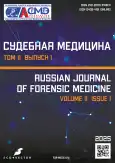Forensic identification of personality: skull as a key element of person identification (a case report)
- Authors: Lavrukova O.S.1, Antipov V.M.2
-
Affiliations:
- Petrozavodsk State University
- Forensic Medical Expertise Bureau of the Republic of Karelia
- Issue: Vol 11, No 1 (2025)
- Pages: 41-48
- Section: Case reports
- URL: https://journal-vniispk.ru/2411-8729/article/view/287949
- DOI: https://doi.org/10.17816/fm16234
- ID: 287949
Cite item
Full Text
Abstract
One of the most sophisticated types of examinations conducted in forensic practice is person identification. If genetic data are available for comparison, the identification of an unidentified cadaver is currently not challenging. The methods given in the report have shown their reliability and effectiveness for the identification of unidentified cadavers.
This case report describes a case of an extremely problematic identification of a deceased person. The medical and forensic department received fragments of an unknown cadaver found on the lake shore (skull with lower jaw, symphysis and proximal ends of the humerus and femur). Sex, age, and race were established during the examination, and the specific dental features promoted the reliable identification of the deceased person. The law enforcement investigation gave grounds to assume that the cadaver was the missing male K., a native of Kazakhstan, whose data coincided with the results of forensic medical examination. This was confirmed by the correlation analysis of craniometric landmarks at the lifetime picture and the skull picture by combining the images of the K.’s head and the skull of an unknown man.
Anatomical features of skull and teeth are significant in forensic identification; its scrupulous analysis contributes to the accuracy of the identification of missing persons. It is crucial to continue the development of technologies and methods of identification, which is especially relevant in the light of a special military operation, with a high demand for identification of deceased persons, including among civilians, yet the availability of genetic research is absent.
Full Text
##article.viewOnOriginalSite##About the authors
Olga S. Lavrukova
Petrozavodsk State University
Author for correspondence.
Email: olgalavrukova@yandex.ru
ORCID iD: 0000-0003-0620-9406
SPIN-code: 6395-8638
MD, Dr. Sci. (Medicine), Assistant Professor
Russian Federation, 33 Lenin ave, Petrozavodsk, Republic of Karelia,185910Vyacheslav M. Antipov
Forensic Medical Expertise Bureau of the Republic of Karelia
Email: antipov528964@mail.ru
ORCID iD: 0000-0001-6683-8701
SPIN-code: 8595-7589
Russian Federation, Petrozavodsk
References
- Christensen AM, Passalacqua NV, Bartelink EJ. Forensic anthropology: Current methods and practice. 1st ed. San Diego, California: Academic Press; 2014.
- Zolotenkov DD, Trufanov MI, Solodovnikov VI. Individual age determination based on computed tomography knee analysis using artificial neural networks and computer vision: Preliminary results. Russian Journal of Forensic Medicine. 2023;9(4):403–412. doi: 10.17816/fm11915 EDN: RZEEGC
- Schotsmans EM, Márquez-Grant N, Forbes SL. Taphonomy of human remains: Forensic analysis of the dead and the depositional environment. 1st ed. Oxford: Wiley-Blackwell; 2017.
- Zvyagin VN. On determining the age of an adult from the sutures of the skull vault: Methodological recommendations. Moscow; 1975. 19 р. (In Russ.) EDN: XXOAFT
- Sjøvol Т. Tables о the combined method for determination оf age аt death given by Nemeskeri, Harsanyi аnd Acsadi. Anthropol Közl. 1975;19:9–22.
- Zvyagin VN. Forensic skull identification [dissertation Abstract]. Moscow; 1981. 29 р. (In Russ.) EDN: XWGSDH
- Antipov VV, Antipova SI. Ethnic aspects and cross-disciplinary problems of medicine. Part 2. Cross-disciplinary ethnic problems of medicine. Medical news. 2016;(9):21–28. EDN: WMGTZZ
- Zvyagin VN. The technique of cranioscopic diagnostics of human sex. Forensic medical expertise. 1983;26(3):15–17. EDN: YCZTDV
- Popov EN, Losev FA, Kosenko YuV, et al. Evidence importance of forensic dental research in the identification of the person. Zagal'na patologіya ta patologіchna fіzіologіya. 2014;9(3):16–19. EDN: UDUWVN
- Barinov EKh, Manin AI, Romodanovsky PO, Maltsev AE. Anatomical features of teeth and their use in identification of individuals. Medical newsletter of Vyatka. 2019;(2):27–30. (In Russ.) EDN: SREDTQ
- Musabekova SA. Identification of human’s teeth in forensic practice. Medicine and ecology. 2017;(1):119–122. EDN: DAQLHT
- Manin AI, Barinov EKh, Romodanovskii PO. Identification of an individual by dental abrasion. Russian Journal of Forensic Medicine. 2019;5(S1):174. (In Russ.) EDN: JZKTXK
- Romodanovskii PO, Barinov EKh, Bisharyan MS, et al. Use of anatomic signs of teeth in personal identification. Bulletin of forensic medicine. 2012;1(3):29–32. EDN: PWZPCP
- Masterova IV, Gabrielyan IK, Khvan VI. The ethnic factor in dentistry as a component of personalized medicine. Stomatologiya. 2019;98(5):108–112. doi: 10.17116/stomat201998051108 EDN: BLMJUH
- Pashkova VI, Reznikov BD. Forensic identification from bone remains. Saratov: Izdatel'stvo Saratovskogo universiteta; 1978. 320 р. (In Russ.)
- Pyatkevich MM. Quantitative expression of some morphological relationships between the human head and skull at comparison of their photographs (Materials for forensic identification of personality by skull) [dissertation Abstract]. Moscow; 1974. (In Russ.)
- Antipov VV, Antipova SI. Ethnic aspects and interdisciplinary problems medicine. Part 1. Ethnic health issues. Medical news. 2016;(7):40–48. EDN: WIMNGX
- Darenskaya MA. Thnic and regional aspects of the human pathology processes. Bulletin of Eastern-Siberian scientific center. 2012;(2-2):152–159. EDN: PCQIYT
Supplementary files













